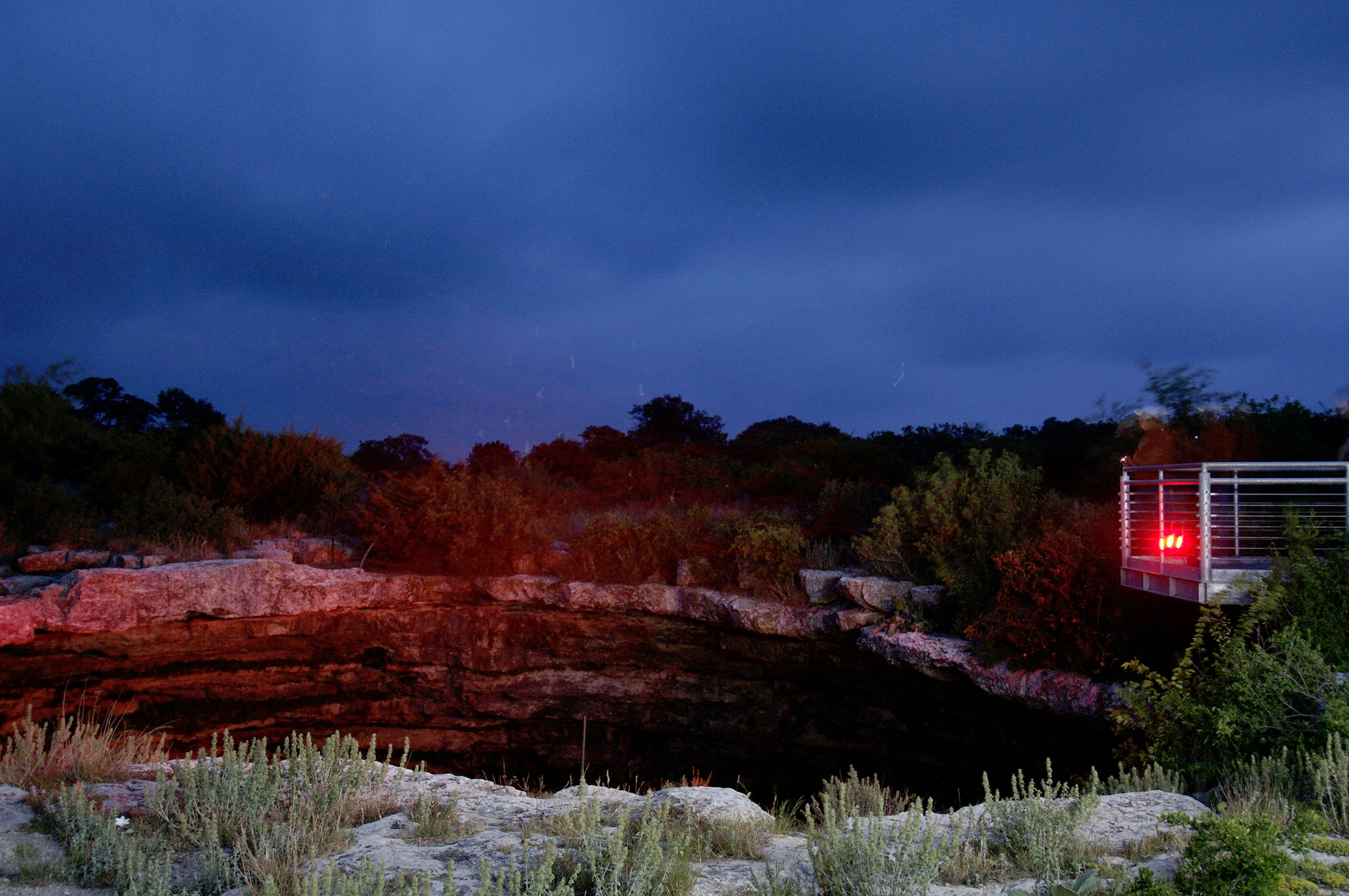
The mouth of Devil’s Sinkhole, where Mexican free-tailed bats arise at twilight from their summer home at Devil’s Sinkhole State Natural Area. Photo by Kevin B. Stillman.
The Texas State Parks system marks its 100th anniversary this year. With 89 parks, natural areas, and historic sites to choose from, visitors can experience all kinds of outdoor activities. Each month, we’re highlighting one these activities based on the season and special occasions around the state.
A million or so years ago in what is now the Texas Hill Country, slightly acidic and slow-moving groundwater carved a cave into ancient rock. Valleys formed nearby and eventually drained the cave. Its ceiling collapsed, leaving a 50-foot-wide circular opening and a pile of rubble, called a breakdown mountain, about 150 feet below it.
Devil’s Sinkhole Bat Tours
Address:
101 N. Sweeten St.
Hours: Wed through Sun at approx. 7 p.m.
Phone:
830-683-BATS (2287)
Fee: Adults $14, 65 and up $11, kids 4 to 12 $6, kids under 4 free
Website: tpwd.texas.gov/state-parks/devils-sinkhole/#battours
Named the Devil’s Sinkhole, the cavern chiseled into Edwards Limestone slopes downward from the rubble to a depth of about 350 feet and more than 1,000 feet across at its widest point. It ranks as the largest single-chambered and fifth-deepest cave in Texas, and in 1971 it was designated a National Natural Landmark.
Its location is on a former working ranch near Rocksprings, 140 miles northwest of San Antonio. Devil’s Sinkhole State Natural Area covers 1,860 acres atop the Edwards Plateau and is about as wild as a state park facility gets. Live oak trees shade the uplands and craggy canyons contain escarpment black cherry, oak, and pinyon pine trees. Facilities are limited to bathrooms and visits are guided, by reservation only.
People come just to see the sinkhole, which early discoverers reckoned was a gateway to hell. But the main attraction is its residents—one of the largest colonies of Mexican free-tailed bats in Texas.
The bats roost here late spring to early fall, say Texas Parks and Wildlife Department bat specialist Nate Fuller. “The sinkhole appears to be a migratory stopover or a temporary roost,” he says, adding that it’s not a maternity roost like Bracken Cave or Austin’s Congress Avenue Bridge. “Pregnant females may stop here and then go on to find a maternity roost. It doesn’t have the proper temperature profiles for raising pups.”
Every night, the bats spiral up out of the sinkhole opening and spread over the Hill Country to consume bugs.
“Free-tailed bats can eat half to three-quarters of their weight in insects, something like 7 grams [or about a quarter of an ounce] of insects per bat per night,” Fuller says. Multiplied by millions of bats, that is a lot of bugs, many of them agricultural pests. These mighty little insect eaters save Texas farmers billions of dollars in foregone pesticides.
Bats can generate significant tourism income and interest for local communities, Fuller says. For instance, a few years ago, the colony at the Congress Avenue Bridge was bringing in $10 million annually. “Plus, it’s a natural wonder to watch that many animals in one place doing the same thing at the same time,” he says.
The Devil’s Sinkhole Society offers evening tours of the bats emerging Wednesday through Sunday from the first of May through the end of October. Guests meet at the Visitors Center on Main and Sweeten streets in Rocksprings and travel the 8 miles to the site by caravan.
Starting time of the tour changes depending on sunset, which is when the bats start coming out, says sinkhole office manager Emma Barnebey. Tours last about 90 minutes, depending on bat behavior.
“Our bat numbers are highest at the end of the season, in September and October,” Barnebey says. “We can reach up to an estimated 6 million bats at that time. At the beginning of the season, it ranges from seeing a handful of bats a night to seeing several thousand.”
Day tours and nature walks are offered Wednesday through Sunday at 10 a.m. and 1 p.m., she adds. “The day tour is to see the sinkhole, basically the bat tour without the bats. We have a one-mile nature walk as well.” Flora and fauna that visitors may see on the walks include black-capped vireos and Tobusch fishhook cactus (formerly an endangered species, its status changed to threatened in 2018).
Limited lodging is available, with three hotels in Rocksprings: Historic Rocksprings Hotel, Pineview Inn, and Mitchell Lodge (call 830-683-2184 for information).
The nearest camping is at Kickapoo Cavern State Park, 40 miles down Ranch Road 674, with five full hook-up campsites and 10 water-only sites (entrance fee $3 age 13 and up). Kickapoo’s Stuart Bat Cave also hosts thousands of Mexican free-tailed bats, and park guests can watch them emerge at dusk each night from mid-March to late October.








